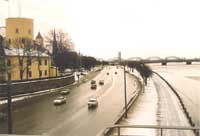Riga Castle with the Fragments of the Bastion
Architectural monument of national significance.
Dates from 1330; the 14th - 20th century.
3Pils Square
The foundations of Riga Castle were laid in 1330. It was a three-storey building with an inner courtyard and 4 towers. Until 1470 Riga Castle was the headquarters of Livonian Order administration, but later the mestr, due to the continual quarrels with City Council, moved his seat to Vilande and later to Cesis. Citizens destroyed Riga Castle, and it was restored in 1491-1515. Then the present Plum bum Tower was built in the present shape, the destroyed dining-hall was decorated with star and cell vaulting; sculptural mouldings to Order's patroness Holy Maria and mestr of the Order V. Pletenbergs were situated on the top of the gate. These sculptural mouldings are significant monuments of medieval art and they are exhibited in the inner courtyard of the Castle. In 1562 the Livonian Order was eliminated and gradually the Castle lost its significance as a separate fortificated place and the Castle was included in the common fortification system of the City.
Polish, Swedish and Russian government representatives ruled next centuries in the Castle. The fortification ditch was filled up in the early-eighteenth century, but the Castle Square was developed in the late-eighteenth century. The most significant developments took place in the 18th and the 19th century. The new corpus of the building was developed in 1785-87; it was a three-storey building for administrative purposes of gubernia (architect J.P.Boks). In 1818 the representative premises for general gubernator of Vidzeme were developed in 1818, including so-called White Hall, in the front of the castle. The State Museum of Arts was established in these premises in 1920. In 1952 the Museum was renamed the State Museum of Fine Arts, in 1964 - Foreign Arts Museum.
The Three Star Tower was built in the thirties of the twentieth century under the supervision of architect E.Laube. Part of the Castle was adapted for the representations of the State President. The Red Hall was developed.
The Plum bum Tower was partly reconstructed in 1958-62 under the supervision of the architect L.Liepa; the part of the damaged bay window mouldings in White and Red Hall was replaced by new ones.
© Artificial Intelligence
Laboratory, IMCS,
University of Latvia |
 |


























